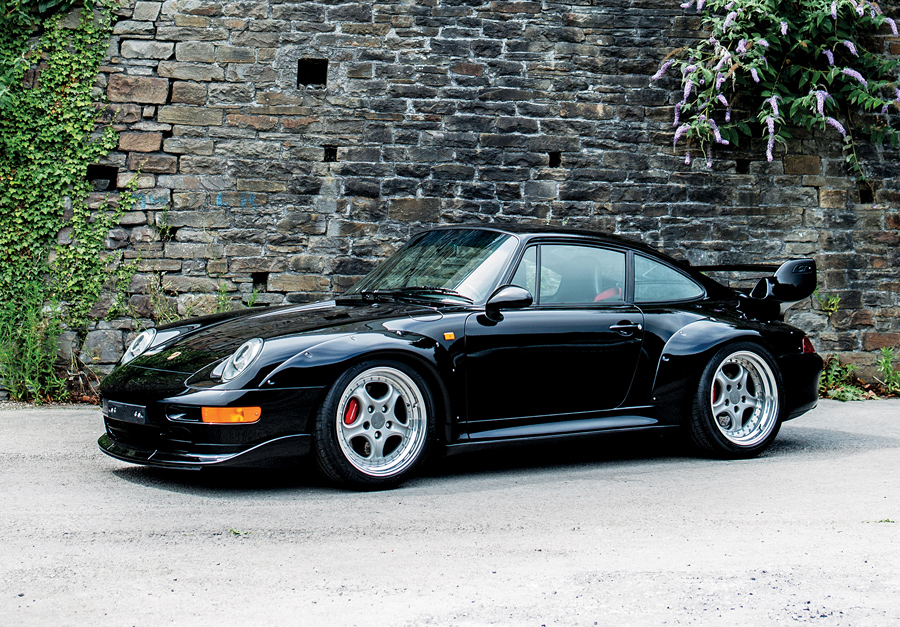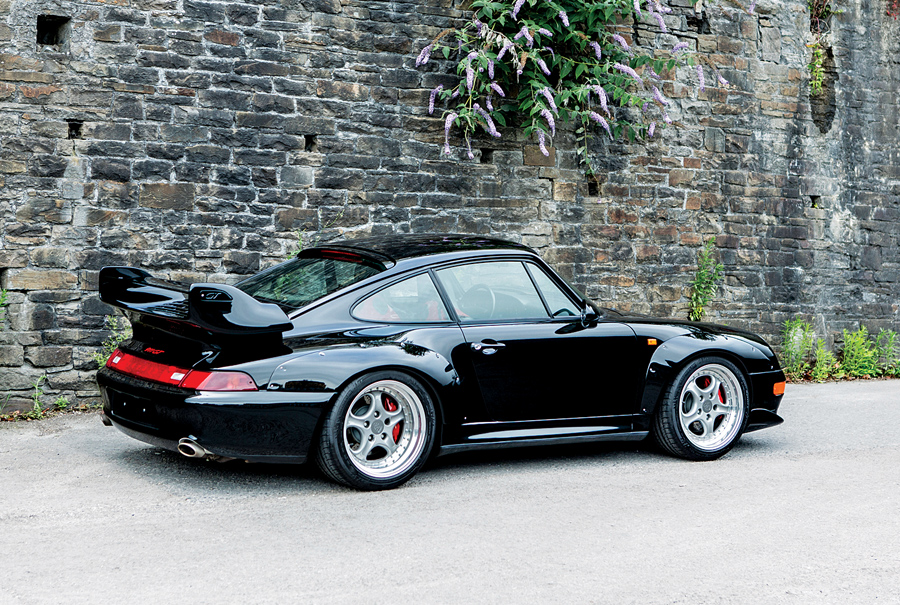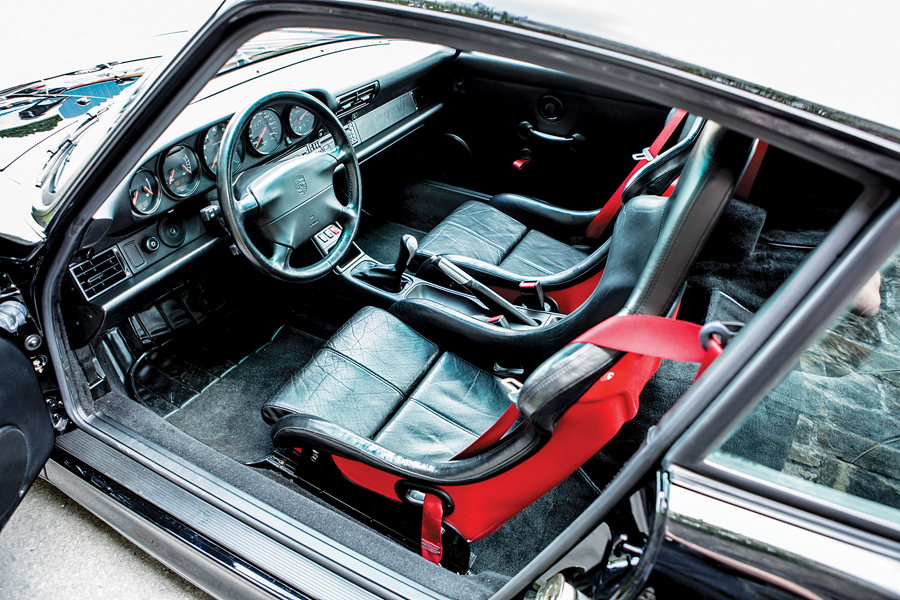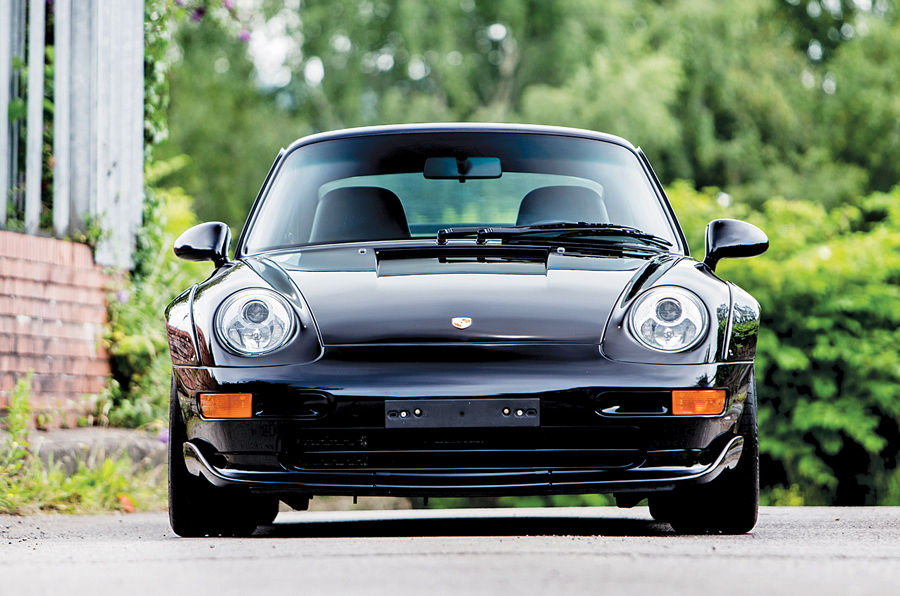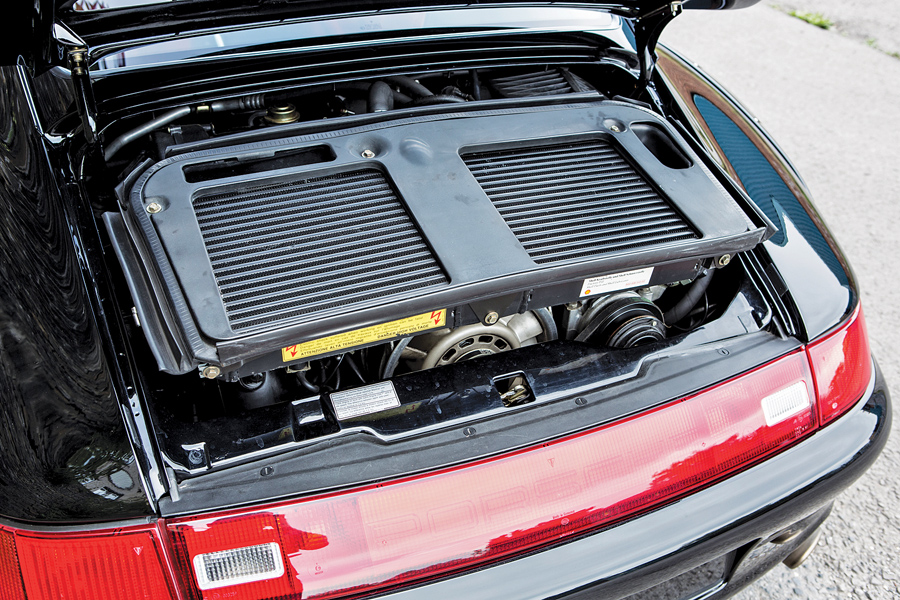- One of just 161 road-going 993 GT2s
- Last of the great air-cooled turbocharged Porsche 911s
- Just 18,000 km (11,184 miles), with minimal recent use
- Extensive service records and magnificent in black over black
SCM Analysis
Detailing
| Vehicle: | 1996 Porsche 911 GT2 |
| Years Produced: | 1995–98 |
| Number Produced: | 194, including 161 Strasse cars and 33 Club Sports |
| Original List Price: | $195,000 |
| SCM Valuation: | $1.3 million |
| Tune Up Cost: | $3,000 |
| Chassis Number Location: | Aluminum tag on passenger’s side inner fender inside trunk; stamping on cross member below gas tank; tag on driver’s side windshield base |
| Engine Number Location: | Passenger’s side of fan upright support, under a lot of gear (bring a small long-handled mirror and flashlight) |
| Club Info: | Porsche Club of America |
| Website: | http://www.pca.org |
| Alternatives: | 1994–98 McLaren F1, 1995–97 Ferrari F50, 1996 Porsche GT1 |
| Investment Grade: | A |
This car, Lot 111, sold for $1,012,160, including buyer’s premium, at RM Sotheby’s London, England, auction on September 6, 2017.
The 993 GT2 is an immensely desirable, iconic, collectible Porsche. It is the ultimate Porsche road warrior, and it is one of the foremost iterations of the famous line of Hans Mezger-designed Porsche engines. Almost any GT2 is worth a million dollars, but how do you value a wrecked and repaired one?
Porsche Factory “hot rods”
The GT2 had its modern origins in the 1992 revival of the Carrera RS in the new 964 variant. That car initiated a run of improved performance Porsches that were sold only in the “rest of the world” (ROW in Porsche parlance) — meaning not in North America.
These cars were often homologation cars, and Porsche could sell out the required production without destroying a couple of cars in U.S.-mandated crash testing or incurring the expense of EPA- and DoT-required equipment.
The 993 RS, introduced in May 1995 as a 1996 model, was next. It was more civilized than the 964 RS, with the new rear suspension that traded out Porsche’s long-lived trailing arms for an aluminum sub-frame that carried dual wishbones.
Suddenly, Porsche 911 rear ends were (relatively) stable, which was appreciated by all — save a few diehard fans of trailing-throttle oversteer. The car was reportedly part of a $500 million development project under the leadership of Ulrich Bez and Peter Falk.
The 993 also introduced a new appearance for 911s, with more voluptuous sculpting, flared-in headlights, and truly integrated bumpers. Further, the RS engine introduced the VarioRam induction system that utilized telescoping induction tubes to improve mid-range torque.
Like the 964 RS before it, the 3,050-pound 993 RS was a homologation car to qualify the 993 RSR 3.8-liter for the BPR Series class N/GT.
But Porsche was not done with the new platform.
Enter the 993 Turbo
Part of the Bez/Falk development program was to modernize the Porsche Turbo, which had been mechanically under-developed for too long — although a new 3.6-liter engine had been brought online at the end of the 964 run in 1994.
For the 993, Porsche chose the Carrera 4 (four-wheel-drive) drivetrain, thinking it to be a better — and safer — way to give customers 408 horsepower in a street car. Smaller, faster-spooling twin turbos, one for each cylinder bank, helped generate 408 horsepower, with 0–60 mph times of under four seconds and top speeds at 180 mph.
Then the GT2 — the ultimate air-cooled Porsche 911
The BPR Global race series “big class” accepted turbos but not in four-wheel-drive configuration.
Jürgen Barth’s Customer Racing Department took up that challenge and created the GT2 street car to homologate the GT2 race car. Using a Turbo body, with a two-wheel drivetrain and sawed-out fenders capped with massive bolted-on fiberglass fender flares, the GT2 looked the part. Visceral. Mean. Fast.
That’s part of the magic of the cars today.
Aluminum doors and hood, titanium wheel centers, stripped interiors, no undercoating or sound deadening, and no power-assisted anything in stock form combined to lighten the GT2.
The result was 3,100 pounds, some 400 pounds less than a street Turbo. The engine turned out 430 horsepower, rated conservatively as always. Horsepower was increased by small tweaks to 450 horsepower for the last 21 examples built in 1998.
Power-to-weight was exemplary, and that’s the rest of the magic of the cars today.
Before you set your sights on a 1998 model, be advised that it lost the aluminum doors, which some collectors consider a meaningful loss in comparison to the earlier models.
The market has spoken — these cars are desirable
GT2s were introduced at about $195,000. Porsche built 194 of them over three years, including 161 Strasse cars and 33 in Club Sport form for track use, with no rugs with racing seats and a full roll cage.
A separate series of race cars totaled 79 cars. In the United States, they are famous because of the Champion Porsche and Jochen Rohr GT2s that either won or placed 2nd at Sebring, Daytona, and other tracks from 1995 through 1998.
Your correspondent has been buying, selling, and importing GT2s since 2012, so I have witnessed firsthand the explosion in interest and values.
The fuss is thoroughly warranted. The GT2 looks awesome, and it drives better than it looks.
Almost all collectors of high-performance 911s have or want one. In 2012, these cars were $400k. By 2015, they were routinely over $1 million, and very good ones with all-original paint were $1.5 million. An outlier, one of two in Riviera Blue (a color that is hotter than hot on all 993s), sold at RM Sotheby’s London in September 2016 for $2,476,000.
RM Sotheby’s current London car had a big issue
All this brings us to our subject car.
Photographs show the car to be attractively turned out. Black is a preferred paint color on GT2s, and Porsche built only 15 in that shade. Some of the red trim is a bit jarring, but that is not a big issue.
The car has optional air conditioning, radio and power windows. Those options are not to every collector’s liking, but they generally help sales by making the car more usable. This example had a documented two-owner history in Germany. The car also benefited from having collector-car mileage: 18,050 kilometers on the clock, which is about 11,200 miles.
Of course, 90% of the usage could have been at full-tilt-boogie at Nürburgring and Spa. We know the car was tracked.
RM Sotheby’s disclosed that the car had a front-and-rear-end crash at Nürburgring in 1999, after which it was rebuilt at the Porsche factory. It is possible that this GT2 was a track car for four years.
My practice is to sprint away from such cars because you never truly know what lurks underneath.
Of course, we trust Porsche to properly rebuild a GT2. But what about engine wear? Two-hundred laps at Nürburgring and Spa will do in the best of them. Suspension? Most importantly, that wreck is now permanently documented on the Internet — never to disappear.
Could you easily resell the car? Any collector we know would shun it, and a million-dollar “driver” GT2 seems a bit of an oxymoron. All that said, with no accidents and all-original paint, even with patina, the car might have done $1.5 million. I will call it well sold. ♦
(Introductory description courtesy of RM Sotheby’s.)
